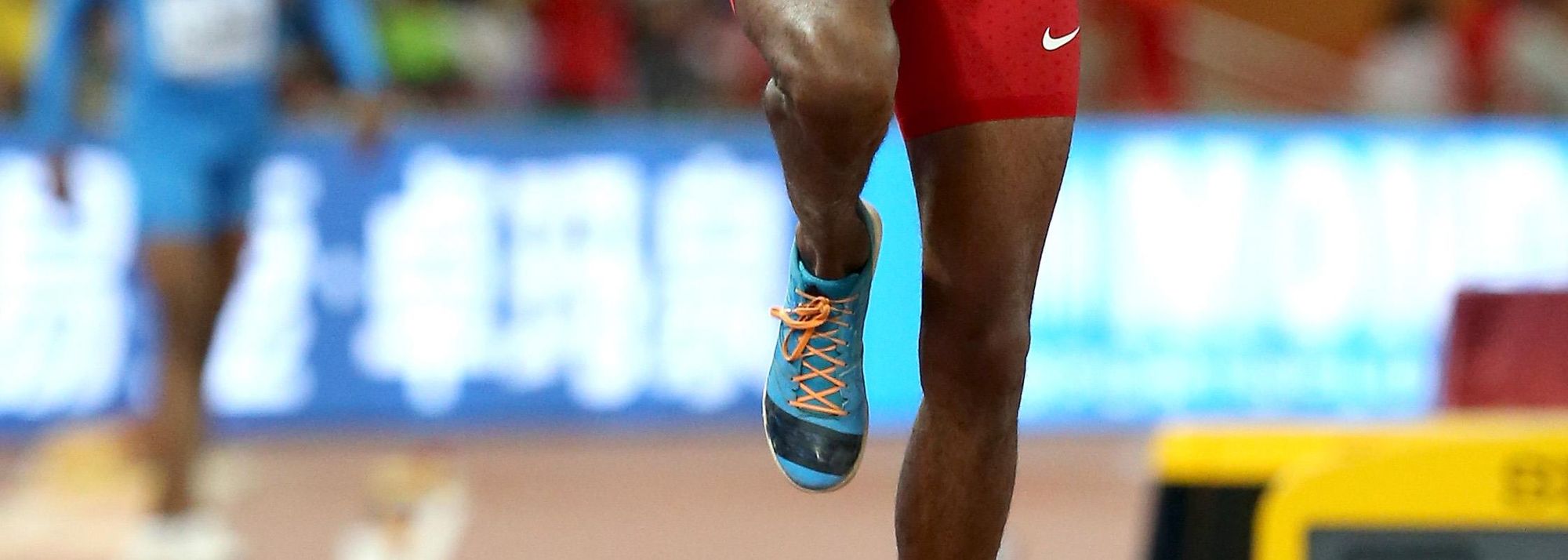Christian Taylor in the triple jump at the IAAF World Championships, Beijing 2015 (© Getty Images)
Christian Taylor produced the second-longest jump in history to take his second world title in the triple jump on Thursday night.
A contest which for a long time did not live up to expectation, exploded into life in the last few jumps. All the medals changed hands in the last three rounds, the bronze doing so in both the fifth and final round of jumps.
Pre-competition, there was talk of the USA’s four representatives taking the first four places for the University of Florida, the university they all attended. Instead, two did not even make it to the final.
It pays to speak softly and carry a big stick, because Taylor’s 18.21m final jump, just eight centimetres short of the championship and world record of 18.29m set by Jonathan Edwards in Gothenburg in 1995, coupled with Omar Craddock’s fourth place was an adequate return, even if well short of such hype.
All year long, Taylor and Pedro Pablo Pichardo of Cuba have duelled near the 18-metre line. And it was Pichardo who led for most of the competition.
Taylor crept up on the take-off board, on Pichardo and, finally, on the world record the longer the competition went.
Nelson Evora of Portugal, winner of the Olympic gold medal in this stadium seven years ago, produced a 17.52m final-round effort – his best leap since the 2009 World Championships – to tip Craddock out of the bronze medal. Evora’s performance was just 15 centimetres shy of his gold medal performance in 2008.
Jumping second in the order, Pichardo opened with 17.52m and then went to 17.60m in the third round as Taylor got into the neighbourhood of the take-off board without actually setting foot on it.
The 2011 champion’s first jump was a modest 16.85m, delivered from a massive 35 centimetres behind the board. Taylor’s second round of 17.49m – just three centimetres behind Pichardo at that stage – was still not on the board at 22 centimetres behind. He finally got a foot on the board with his own 17.60m in the third round.
At half-way, the two favourites were tied on distance, with Pichardo leading with a superior second jump.
Now landing consistently on the board, if not more than half-way on it, Taylor took the lead in the third round at 17.68m. Under pressure, Pichardo produced a 17.33m leap as he missed the board and then another 17.52m.
Behind the leaders, the bronze medal position was changing by the round. Craddock had it at 17.14m after the first round before Taylor pushed Evora down to third in the second round. Lyukman Adams of Russia put in a bid with 17.28m in round three.
Craddock seemed to have clinched matters when he topped that with 17.37m in the fifth round, vaulting from fifth place to third. But he could not respond to Evora’s final-round effort of 17.52m.
Now only Taylor and Pichardo were left to jump, the US jumper first as the Cuban had led at half-way.
Taylor gathered himself, sped down the runway and hopped, stepped and jumped all the way out towards the virtual red line representing Edwards’ unattainable world mark. He landed just eight centimetres short, 18.21m, emerging upright from the pit and taking a little bow to the crowd.
Eighteen-point-21, and not even a championship record. By way of consolation, Taylor at least displaced 1996 Olympic champion Kenny Harrison as US record-holder.
Pichardo had one last go, producing his best of the competition with 17.73m. It was not a case of too little, too late; Taylor had simply produced too much, too late.
Len Johnson for the IAAF



